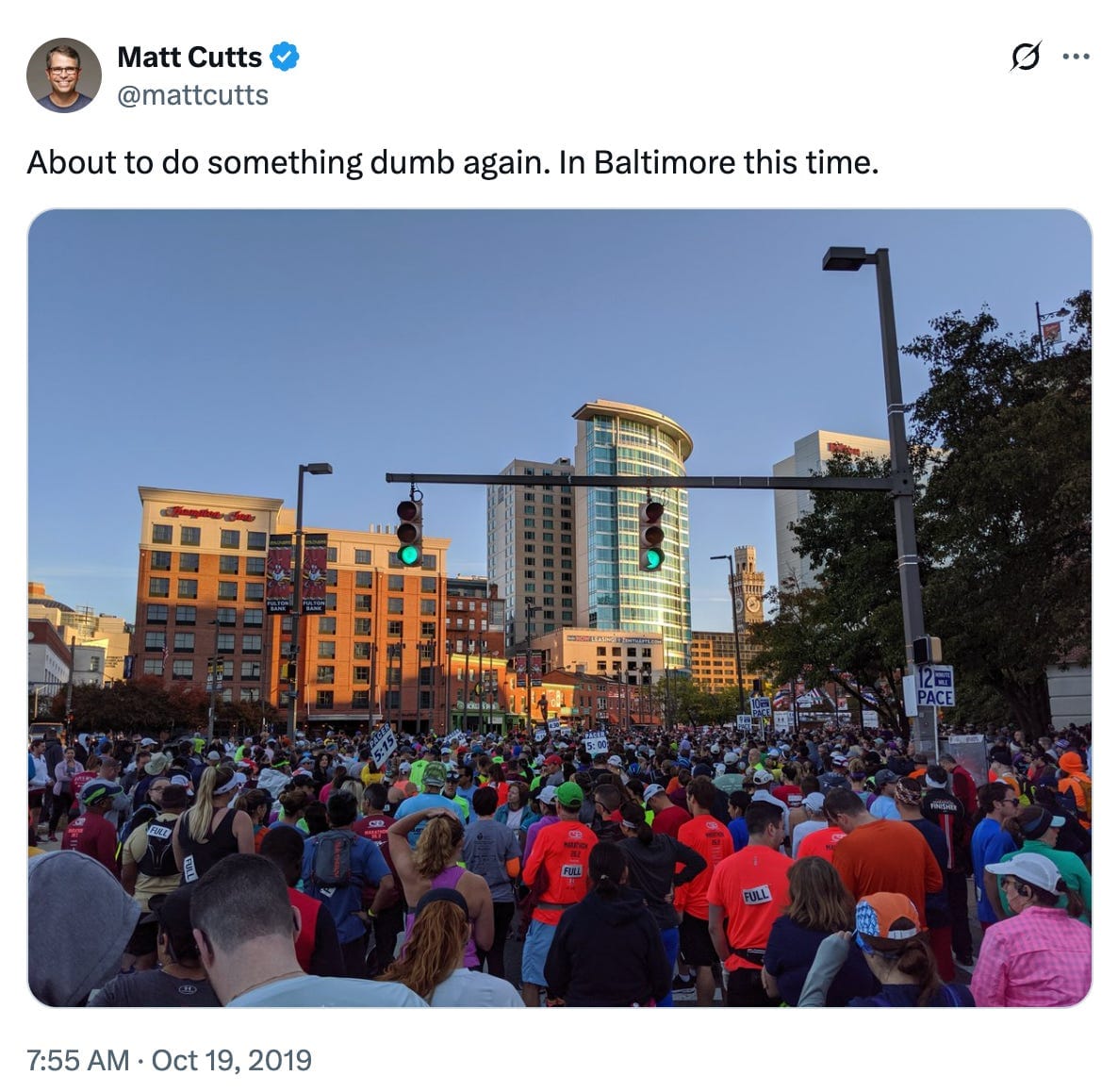On running, sports, and how we connect with each other
As my mileage increases (slowly) ahead of the Twin Cities Marathon this October—and California International Marathon after it, in December—I’ve been thinking of Matt Cutts.
For those who don’t know Matt, he was the administrator of the U.S. Digital Service, first in an acting capacity and later officially, during the entirety of the first Trump administration. He handled that difficult job with grace and savvy and is someone I have looked to as a mentor and role model—especially given the parallels with my job now.
Beyond his stewardship of USDS during Trump one and his Google engineering days, Matt is also a member of the 50 States Marathon Club—which is worth checking out if for nothing more than its throwback web design. Perhaps paradoxically, you are eligible to join when you’ve completed marathons in (only) 10 different U.S. states.
From time to time, Matt would post on Twitter something like the below and it would always impress me. How could someone who had such a demanding job find the time to train for a marathon?

I was just getting into running back then (I ran my first half marathon in November 2019) but something about Matt’s posts stuck with me, and eventually I caught the marathon bug myself. My current job isn’t quite comparable to Matt’s at that time but now six marathons later in four states and two countries[1]—with two more loading this fall—I think I get it.
For me, running has always been meditative in the way that it forces me to focus on my breathing and on my thoughts—especially since I never run with music (crazy, I know). I love to run after work so I can cycle all the stray thoughts that have piled up during the day in a series of inhales and exhales and leave them somewhere on the streets and sidewalks of DC. Being outside[2] and exercising are natural de-stressors and I have on many occasions described post-work runs as me “running away from my problems.” Phone-free and unplugged from the world, I cherish my post-work runs that also function as a helpful demarcation between the workday and the rest of my evening.
And now that I’m in a position where I have some people who I’m responsible for—fewer than Matt, to be sure; some of whom who I join on runs from time to time—I do hope that they see me trying to carve work-life balance in part through running in the same way I saw Matt: that they can and should strive for balance, too, in their own way.
My dad will tell you that, growing up, I was never fast or even particularly adept at running. But there’s something democratizing about running—at least in theory. All you need is a pair of running shoes and you can get outside and run, and with enough hard work, you can get faster.[3] Consistency is key, and so is listening to your body instead of blindly following a training plan—both seeds of broader life lessons, I feel. And for data nerds like me, it is so satisfying to see can that self-improvement as you stack runs.
Going back to the implied theme of the 50 States Marathon Club, running has also been a fun way to structure travel—both as a way to pick a destination (e.g. Amsterdam and Twin Cities) or as an add-on to work or personal travel. I’m convinced running is the best way to get to know and get a feel for a new city since you are not moving so fast that small parts of life go by in the blur of a car window. You physically experience how a city values pedestrians and cyclists relative to cars. You sense the sights, sounds, and smells of local neighborhoods—the languages overheard and displayed on storefronts. You are forced to learn some directional sense so as not to be consulting your phone at every turn. You stumble upon cute neighborhoods, streets, and shops to return to post-run.

In a more local version of the 50 states club, I’ve had it on my DC bucket list to run at least one block on each of the avenues named after a state or territory. As of today, I’ve hit 23/51 and am hoping to get out of my Dupont Circle/NW bubble and explore more of the city that’s now under federal occupation (a whole different topic).
And in one way that running is like other sports—it’s been an incredible way for me to build community for me in DC. It’s no exaggeration that some of my closest DC friendships have been forged by conversations over miles along the Potomac, in Rock Creek Park, and along Hains Point and the National Mall (and you can’t forget the inevitable post-run beer/coffee).[4] It’s not the run club as dating scene energy that has taken over Instagram, but more similar to social sports like Volo. Friendship in adulthood often comes down to repetition, repetition, repetition and coincidentally, so does running.[5]
This has turned into a little bit of Haruki Murakami’s What I Talk About When I Talk About Running, and the community aspect calls back to the Lowell speech I gave in college, so I’ve decided to append some of those thoughts below as well.
Four years ago, I gave a Lowell speech during my senior year of college. The speech, and the process building up to it, is still one of the memories I cherish most about my time at Harvard.
I spoke about sports and how they are much more than scores and statistics (the title of the speech, “It’s only a game,” I borrowed from a short-lived NPR podcast with a similar bent). It’s a belief that, if anything, has only strengthened in the last four years.
On the eve of a new Patriots season and as the Red Sox play meaningful September and hopefully October baseball—there’s nothing like the hope of a new season.[6] Sports are a story of persistence and of underdogs. In a highly mobile and fractured world, sports are also how we stay in touch with our families, friends, and our hometowns.
Sports bring people together across race, class, and other lines and are probably the closest we have to a shared, secular religion in America today. However, at the same time, it’s shallow to say that sports have healed our social divisions as progress on the field—whether integration, Title IX, or the recent rise of professional women’s sports—has rarely reflected the messy reality of glacial gains at a societal level.
Nonetheless, sports are a way Americans have come together to process shared traumas and demonstrate our resilience, whether it is President Bush throwing a ceremonial first pitch at Yankee Stadium following 9/11 or David Ortiz post-Boston Marathon bombing:

"We want to thank you Mayor Menino, Governor Patrick and the whole Police Department for the great job they did this past week.
This is our fucking city, and nobody gonna dictate our freedom.
Stay strong, thank you.”
Growing up in Boston, the marathon always held a special meaning for me—and that was before the 2013 bombing that shocked the region and spawned the term “Boston Strong.” So a special thanks to my dear friend Kristie Colton for allowing me the honor of guiding her this April in the 129th running of the Boston Marathon. I can think of few better moments blending friendship and love for the city that’ll always be home. And that’s what sports, and running, is at their best.
Marine Corps Marathon (VA/DC), twice; Foot Traffic Flat (OR); Philadelphia Marathon (PA); Amsterdam Marathon (Netherlands); Boston Marathon (MA). ↩︎
Since I refuse to run on treadmills, almost all of my runs are, definitionally, outside. ↩︎
Reality, however, is messier. Access to runnable infrastructure (sidewalks, parks) is not equally distributed and there are many documented instances of how “running while Black” have resulted in scary and even deadly outcomes. ↩︎
Special shoutouts to Meera, Emily, and Mia: close friends and the (main) marathon crew for Twin Cities. ↩︎
Obligatory shoutout here to the niche social media sites—Strava, Goodreads, Beli, etc. ↩︎
Evergreen recommendation for Doris Kearns Goodwin’s beautiful memoir, Wait Till Next Year. ↩︎
